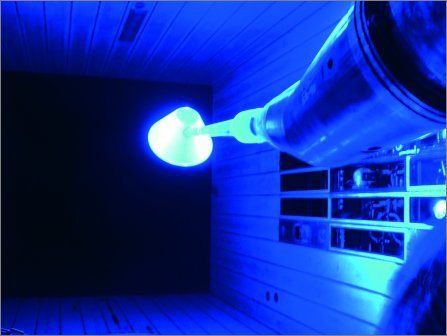Agency says that making crew module design smaller will give performance benefits
NASA is on the verge of selecting a baseline crew exploration vehicle (CEV) design with a 5m (16.5ft)-diameter crew module, 0.5m smaller than originally considered. Expected to be confirmed in coming weeks, the change is linked to initial configuration studies showing that the size and weight reduction in the CEV and associated crew launch vehicle (CLV) will give performance benefits.
|
Scale models of the crew module are undergoing initial windtunnel tests |
Studies also showed that the CEV did not require all the capacity of the 5.5m-diameter module for low-Earth orbit (LEO) and lunar missions. By selecting the smaller vehicle size NASA is also expected to gain potential room for growth.
The size rethink comes as initial tests get under way on CEV models at NASA Ames Research Center’s Unitary Wind Tunnel complex near Mountainview, California. Tests are under way on 2.7%- and 7%-scale models, with data being passed to Johnson Space Center (JSC), which is leading CEV work. “We’re trying to get a baseline configuration to help JSC work out how much it will cost and how long it will take to build,” says Tom Edwards, director of aeronautics at NASA Ames. “We [NASA] are not going to build it, but we need to be able to define the requirement.”
Initial aerodynamic testing uncovered “a few questions”, says Edwards. These relate to “the pressure variations over this new shape, and what that means in terms of flying qualities”, he says. “This will fly down to a dry landing, and needs some controllability.”
Edwards cautions that “we are in the first hour of a very long development cycle. As long as we can understand it, we can control it.” A set of trim-tab devices arranged around the circular rim of the crew module is one method of re-entry flight control being considered.
Ames is also involved in developing the CEV’s thermal protection system (TPS), integrated system health management, cockpit design and simulation-assisted risk assessment. Four different vendors are bidding with five types of TPS material, says Ames CEV/CLV programme manager George Sarver. Selection of potential TPS options is due at the CEV preliminary design review, around the end of 2007.
“The big difference from anything we’ve done before is that it will be 5m in diameter, and we need to know what sort of manufacturing quality control will be needed when we’re coming in at 11km/s [6.8 miles/s],” says Sarver, who adds that it is “possible the TPS could be made up in segments”.
The goal is to make the disposable TPS common for both LEO and lunar missions, although a back-up plan is to develop a LEO-only TPS using Shuttle tiles if this proves too ambitious.
GUY NORRIS / MOUNTAIN VIEW
Source: Flight International
























